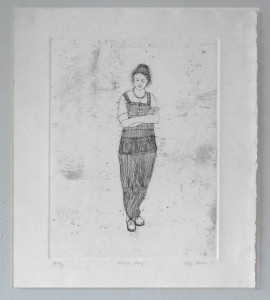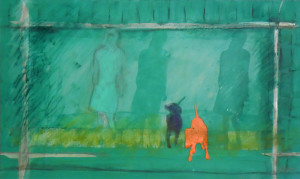Ellyn Bivin’s paintings are by turns colorful, whimsical, thoughtful, and mysterious. Nuanced surfaces, painted with analogous colors, provide the background for local images that appear to dance in their relation to each other. The viewer immediately sees the artist’s joy in playing off visual ideas against each other. Those elements– children, birds, houses, feathers, dogs, and cats– can be dramatically present, partly hidden, or subtly disguised.
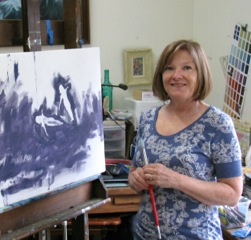
Ellyn in her studio
See more of Ellyn’s art at: Ellen Bivin
For interviews with other painters see: Josiah Golson / David Jones / James Mckissic / Renel Plouffe / James Tucker / Larry Young
Ellyn’s studio, located in a small cottage that once belonged to her grandmother, is just a short walk from the home she shares with her husband, Ken, along the Tennessee River in Chattanooga. It was in this neighborhood, that Ellyn spent her childhood years. The main room of the cottage/studio is well-lit and airy, with several of her recent paintings, in differing states of completion, resting on easels. In the center of the room are tables where she teaches painting. Her student’s work, an assignment based on a still life of lemons, is on the wall. In an adjoining room is a painting by Ellyn’s daughter, Mamie, who is currently an art student at the University of Tennessee, Chattanooga. Indeed, both of Ellyn’s children, her daughter Mamie and her son Robbie, are artists.
“I started as a little girl drawing horses because that’s what little girls do. Over the years my subject matter expanded,” she says with a laugh, “but I am often drawn toward children and animals as subjects. My subjects, however I handle them, are people or animals that mean something to me.”
Ellyn has been a fixture in the Chattanooga art scene since the 1980’s when she showed with a group of artists who formed the collaborative group, Square One. “Ann Poss, a noted regional printmaker, bought a house on Oak Street that she divided into artist studios. Ann had studio downstairs as I did, Alan White, the UTC professor, was upstairs as was Joe Helseth, who is now a professor at Chattanooga State. We were putting on shows around Chattanooga and we decided we needed a name for the group, but we could never agree on one. It always seemed like every suggestion would get rejected. We’d have to start over—we were always going back to square one. Finally someone suggested we use Square One for the name. That group lasted a few years and became part of the origins of the Association for Visual Arts. The Hunter Museum had a show of our art at one point. We called it “Two x Two,” and it traveled to our sister city, Wuxi, China. They sent their art here and we sent ours over to them.”
“I don’t want to nail everything down for the viewer. I want them to use their imagination. I want my pictures to have a bit of mystery about them.”
Ellyn briefly attended the University of Tennessee Chattanooga before transferring and earning a BFA from Virginia Commonwealth University, with an emphasis on printmaking and art education. “I took a beginning course in printmaking as a freshman at UTC and really loved it. When I got to Virginia Commonwealth, it was great. VCU had a printmaking department and absolutely amazing equipment. I just fell in love with the whole process of making prints, particularly intaglio, because I love to draw. I did a lot of lithographs, too, because of the drawing.”
Ellyn loved drawing, but she had no desire to be a painter. “I never got into painting much. I just took painting classes because I had to fulfill my requirements for a degree. I wasn’t a dedicated painter at all. I was a printmaker. I was even snooty about it. ‘Painter? I’m a printmaker!’”
Returning to her home town she enrolled at UTC to take additional course work, though the school did not offer an MFA. “George Cress, the head of the art school at the time, let me use the printmaking equipment. At first I’d pay for a class to make it official, but after a while, he decided I didn’t have to pay if I was helping out around the department. In addition to more routine jobs, I printed editions for the professors. They would design the plate and I would print it.”
It was at this time she became interested in monoprints. The change had an impact on Ellyn’s development as an artist. With lithography or etching, the artist draws with a waxy crayon on a stone or cuts into the surface of a metal plate. The goal is to print multiple copies. With monoprint, as the name implies, only one impression is produced, either by painting or making a collage on a block. Monoprint is the most ‘painterly’ method among the printmaking techniques. For Ellyn, it stood as a bridge between pure printmaking and an embrace of painting.
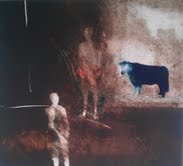
Bivin- Farmer’s Dilemna
“When I began doing the monoprints, I used to lay things down–torn strips of old phone book paper, for instance–and roll ink over them. I would lift that up, maybe roll back over it, wipe some ink out, and then use stencils. I started working in black and white, and I remember the first time I saw the image the ripped paper had made. I thought, ‘Wow! That’s a landscape!”
It wasn’t long before she was using color in her monoprints, and her move toward painting was under way. “As I worked with increasingly complicated imagery and used more colors, the monoprints took more and more time to produce—really, they were paintings.”
“I move elements around on the surface,” she says. “It’s all about balance for me—playing one thing off against another. My imagery is always moving around.”
Ellyn soon found herself doing more and more painting, but in a style that echoed her experiences as a printmaker. Still, she loves the way the monoprints look and seeks to rediscover those effects in her work. “Right now,” she says, “I’m trying to ‘print’ my paintings. By that I mean I’m doing them in layers like I did with the monoprints. I’m trying to use the whole process I used to use doing my monoprints.”
Though she paints on both canvas and rigid supports, she often prefers to work on rugged surfaces like Masonite, which can stand up to multiple reworkings of the surface. Indeed, she says her method of making a painting remains fairly close to the way she produces monoprints, but with the difference that, since the surface isn’t used to make an impression on paper, the image isn’t done in reverse and is the final statement of the artist’s intentions.
“My backgrounds are often based on analogous colors with offsetting highlights. I suppose because of my printmaking background, I just naturally exploit the flatness of the surface plain. Analogous color is a useful part of doing that.”
A painting that is going into her next show features the figures of two girls. The pose of these figures, replicated in different sizes, are unusual, and the shadows they cast form a strong compositional element, which are, from a commonsense perspective, impossible and contradictory. Such considerations don’t matter to Ellyn. She uses all means at her disposal to create a visual world that is at once familiar and ambiguous. “I want to make pictures that cause you to use your imagination. I don’t want to nail everything down for the viewer. I want them to use their imagination. I want my pictures to have a bit of mystery about them.”

Ellyn Bivin 30×30 Green Leaves Acrylic on canvas
As for her subject matter, Ellyn chooses elements from her everyday life, which she celebrates in paint. “I draw my own designs from source materials,” she says. “I like to work with the human figure and with animals. Often I develop ideas from old photographs. I draw my designs and cut out stencils. After putting several layers of paint on a gessoed ground, I then begin moving the stencils around, seeking a balance composition. That’s the great thing about stencils — they allow you to establish composition, which I can embellish or not, depending on the picture’s needs.”
It is this process of carefully working out her composition by manipulating various drawn and stenciled a basic elements against a background painted in layers that gives a dynamic, almost rhythmic, quality to her paintings. These elements can have unexpected relationships that add surprises for the viewer. In the detail of her painting, ‘The Immigrants’ we see several figures, some readily apparent, some drawn in silhouette, some barely suggested, and some seeming to emerge from the background. This, the title of the painting suggests, is the ambiguity of the immigrant experience. A deft use of apparent and concealed meaning reappears in many of Ellyn’s works.

Ellyn Bivin ‘The Immigrants’ 24×30 Acrylic on canvas
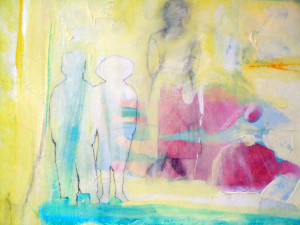
The Immigrants (detail)
Ellyn’s paintings, also reveal her whimsical sense of humor. “I definitely have a sense of humor that I like to bring to my work,” she says. “I even like to give my paintings silly titles sometimes. I had a painting where I used a dog as an important visual element and I couldn’t resist naming it, ‘Where the Nose Leads, the Tail Follows!’. When I was taking a sculpture class I did a series of tongue-in-cheek pieces such as one entitled, Chest of Drawers, which was a human torso with drawers in it. I don’t think art has to be dead serious to be good.”
Return to Interviews with Artists
